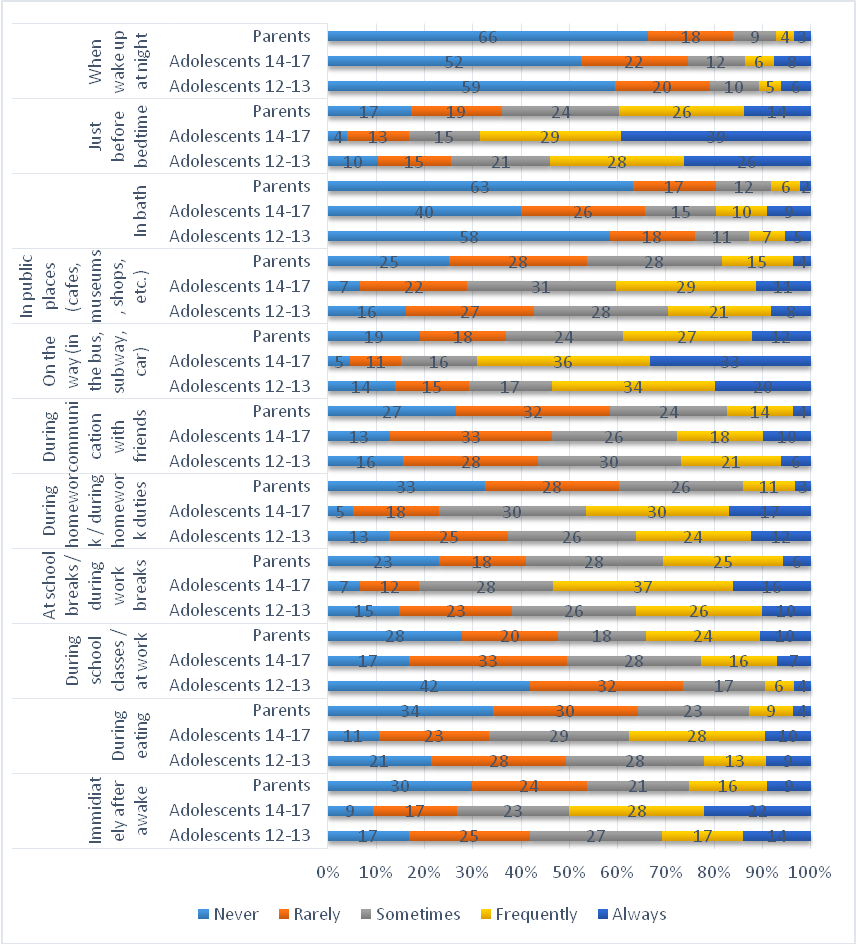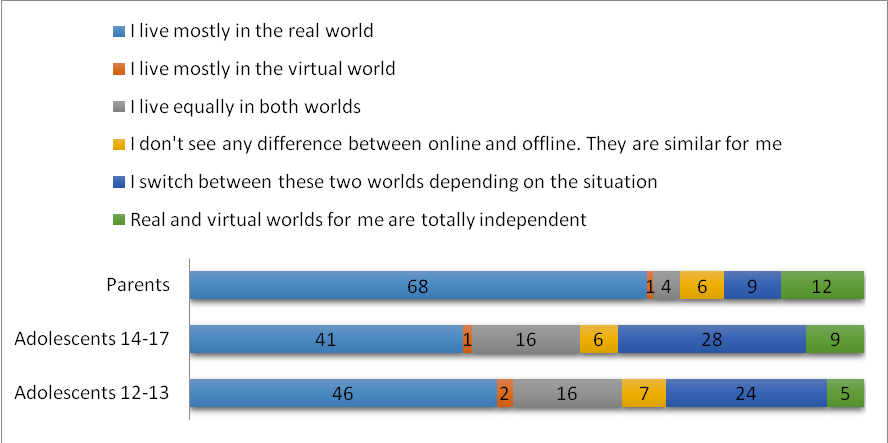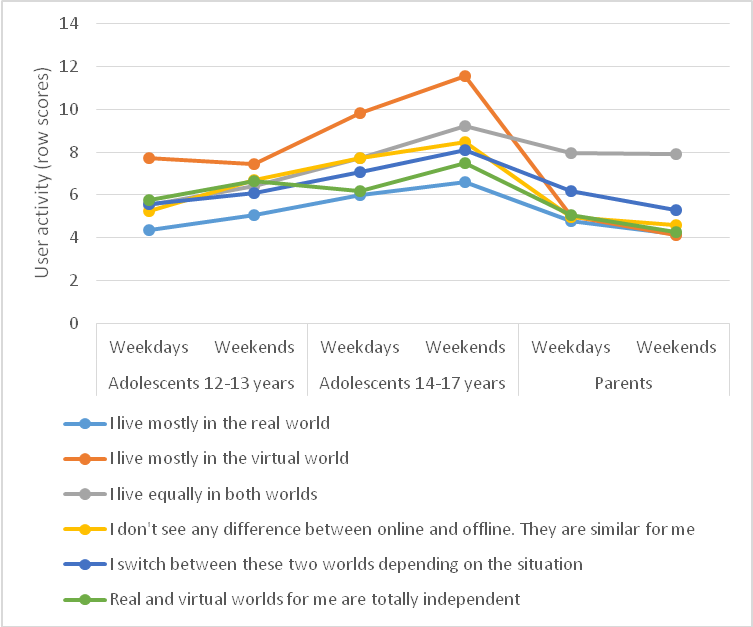Abstract
Rapid Internet development shifted the focus of attention to the recognition of the Internet not as different world but as a social network demanding for studies of digital rules, competence and citizenship. The aim of the study was to reveal and describe the phenomena of “constant accompaniment” of any daytime and nighttime activities by the Internet and switching between online and offline as an important characteristic of digital socialization of contemporary adolescents. 1553 schoolchildren 12-17 years old from 15 cities of the Russian Federation and 1219 parents of adolescents of the same age participated in the study. Participants appraised their user activity, subjective relationship between “real” and virtual “worlds” and frequency of Internet use during different activities (“Immidiately after awake”, “During eating”, “During school classes / at work”, “At school breaks / during work breaks”, “During homework / during homework duties”, “During communication with friends”, “On the way (in the bus, subway, car)”, “In public places (cafes, museums, shops, etc.)”, “In bath”, “Just before bedtime”, “When wake up at night”). According to the results, parents more frequently perceived themselves as living in the “real” world while adolescents perceived themselves as living both online and offline or switching between them. Almost any daytime and even nighttime activity could be supplemented by using the Internet, especially in adolescents. These phenomena are not explained by user activity and typical for both males and females.
Keywords: Digital socializationadolescentsInternet perceptionuser activityRussian population study
Introduction
Traditional metaphor used to describe the Internet is the metaphor of the second “world” differentiating “real” and “virtual” worlds as two spheres of activity (Nosov, 2000). According to it, Internet is typically perceived as one of the personal activities (e.g., user activity) demanding special forms of learning (Gilster, 1997) that could sometimes lead to constriction of the offline activities and substitution of them (Griffiths, 2010). Rapid Internet development shifted the focus of attention to the recognition of the Internet not as different world but as new social network demanding for studies of digital rules, competence and citizenship (Mossberger, Tolbert, & McNeal, 2008). The new metaphor of flowing modernity (Bauman, 2008) leads to consideration of the Internet not as a world but as a dimension supplementing any personal activities. Like a prism, the Internet transform (but not breaks) any personal activity.
Problem Statement
On the practice of psychology of Internet, it means that traditional methods of measuring “user activity” as frequency during weekdays and weekends (for example, Livingstone & Haddon, 2009; Soldatova et al., 2013) may be not ecologically valid enough anymore because people do not divide their time as online and offline. As contemporary changes in Internet perception, they should be more prominent in adolescents than in adults.
Research Questions
The study is devoted to the question of how adolescents and parents of adolescents perceive and use Internet comparing to their offline activities.
Purpose of the Study
The
Research Methods
1553 schoolchildren 12-17 years old from 15 cities of the Russian Federation and 1219 parents of teenagers of the same age participated in the study (see table
Among parents, 220 people were men (18.0%), 959 were women (78.7%), in 40 cases the gender was not indicated (3.3%). In the group of parents, 409 people responded about their teenage children 12–13 years old (33.6%), 796 (65.3%) - about teenagers 14–17 years old, 14 did not indicate (1.1%). 510 people were parents of boys (41.8%), 645 were parents of girls (52.9%), in 64 cases these data were omitted (5.3%).
User activity was assessed by two questions: “How much time do you spend on the Internet on weekdays?” and “How much time do you spend on the Internet on weekends?”. There were 14 variants for answers for each item from “Almost no” and “Less than half an hour per day” to “12 hours per day and more”. Participants have chosen one variant between: “I live mostly in the real world”, “I live mostly in the virtual world”, “I live equally in both worlds”, “I don't see any difference between online and offline. They are similar for me”, “I switch between these two worlds depending on the situation”, “Real and virtual worlds for me are totally independent”.
Subjective relationship between “real” and virtual “worlds” were appraised by single item: “Today it is often said that we live in two worlds - real and virtual. What world do you live in?”
Supplementation of different daytime and nighttime activities by the Internet was measured by 11 items describing different activities. Participants were asked to appraise how frequently they use Internet during each of the activities using 5-point Likert scale (from “Never” to “Always”): “Immidiately after awake”, “During eating”, “During school classes / at work”, “At school breaks / during work breaks”, “During homework / during homework duties”, “During communication with friends”, “On the way (in the bus, subway, car)”, “In public places (cafes, museums, shops, etc.)”, “In bath”, “Just before bedtime”, “When wake up at night”.
Findings
Internet use during other daytime and night time activities
In contemporary world people combine Internet with any activities: even waking up and in the bath almost half of parents and adolescents are online (Figure
For any activities, adolescents are more active Internet users that parents (F=23.73-262.99, p<.05, η2=.02-.18).
In adolescents 12-13 years old there is only one difference in the Internet use: girls more frequently use Internet in bath than boys (t=-2.29, p<.05). In adolescents 14-17 years old females more frequently use Internet than males just after wake up, on the road and before sleep (t=-4.63 - -2.83, p<.01). Similarly, mothers more frequently use Internet than fathers on the road and before sleep (t=-3.82 - -2.14, p<.05).
In all cases, parents use the Internet less often than children during the day and night.

Subjective appraisals of relationship between “real” and virtual “worlds”
Adolescents are more sensitive to this “constant accompaniment” of Internet than their parents. When we asked them in which world, they are feeling they live - virtual or “real” - most adults (67.9%) confidently answer that in the real world (Figure
In adolescents, boys and girls do not differ in their appraisals of “real” and virtual “worlds” while in parents there is a very weak difference (χ2=14.09, p<.05, Cramer’s V=.11) in that men more frequently say that they live equally in both “worlds” than women.

Switching between online and offline: relationship to the user activity.
In both adolescents and parents, the role of online versus offline “world” is related to their user activity (for adolescents 12-13 years old F=7.43, p<.01, η2=.08 for weekdays and F=6.19, p<.01, η2=.07 for weekends; for adolescents 14-17 years old F=12.27, p<.01, η2=.08 for weekdays and F=16.90, p<.01, η2=.10 for weekends; for parents F=12.11, p<.01, η2=.06 for weekdays and F=14.87, p<.01, η2=.08 for weekends). Adolescents feeling that the live mostly in the real world spend least time online and those feeling that they live mostly in the Internet spend their most time while all the other variants are in between (Figure

In all three groups more active Internet users more frequently switch to the Internet during any daytime activities and even when wake up at nights (Table
Conclusion
In accordance with the first hypothesis, while parents perceive themselves as living more in the “real” world than in the Internet, adolescents more frequently perceive themselves as switching between the worlds or living equally in both of them. To our mind, this result indicates that the dichotomy of “real” versus virtual “worlds” is not as prominent for adolescents as for parents. We could further speculate that their socialization is not going partially online and partially offline as their parents would probably perceive it. Rather their socialization has a digital dimension that constantly supplement their offline activities.
As a further support for this hypothesis, almost any daytime and even nighttime activity could be supplemented by using the Internet. This supplementation is more typical for adolescents although it is not as rare in parents as one could suggest. Even waking up, communication “face-to-face” with friends and in bath people remain their online activity.
Both feeling of living merely online than offline and being online during any other daytime activities are more typical for active Internet users. However, wide-spread in adolescents feeling of switching between the “real” and virtual “worlds” and their equivalence seems to be not explained by user activity. We hypothesize that this phenomenon demands psychological analysis from multitask perspective and capability for switching between different tasks that is much more recognized by adolescents than by parents.
Thus, according to our data, for contemporary adolescence but not parents world is not divided into online and offline. Rather, Internet is a dimension of aby activities forming their socialization process in the world. From theoretical perspective, this hypothesis demands for further studies of capabilities for switching between different tasks especially when some of them are online and others are offline. In practice, special attention could be paid to the formulation of research questionnaires to be closer to subjective relationships of adolescents to the Internet.
Acknowledgments
This study was supported by the Russian Science Foundation project No. 18-18-00365.
References
- Bauman, Z. (2008). Flowing modernity. Sankt-Peterburg: Piter.
- Nosov, N.A. (2000). Virtual psychology. Moscow: Agrafa.
- Gilster, P. (1997). Digital Literacy. N.Y.: Wiley Computer Publishing.
- Griffiths, M. (2010). The role of context in online gaming excess and addiction: some case study evidence. Intern. J. of Mental Health and Addiction, 8, 119–125.
- Livingstone, S., & Haddon, L. (2009). EU Kids Online: final report. LSE, London: EU Kids Online. URL: http://www.lse.ac.uk/media@lse/research/EUKidsOnline/EU%20Kids%20I%20(2006-9)/EU%20Kids%20Online%20I%20Reports/EUKidsOnlineFinalReport.pdf
- Mossberger, K., Tolbert, C.J., & McNeal, R.S. (2008). Digital citizenship: The internet, society, and participation. Cambridge, MA: MIT Press.
- Soldatova, G., Rasskazova, E., Zotova, E., Lebesheva, M., Geer, M., & Roggendorf, P. (2013). Russian Kids Online Key findings of the EU Kids Online II survey in Russia. Moscow: Foundation for Internet Development. Retrieved from: http://www.lse.ac.uk/media@lse/research/EUKidsOnline/ParticipatingCountries/PDFs/RU-RussianReport.pdf
Copyright information

This work is licensed under a Creative Commons Attribution-NonCommercial-NoDerivatives 4.0 International License.
About this article
Publication Date
14 July 2019
Article Doi
eBook ISBN
978-1-80296-063-1
Publisher
Future Academy
Volume
64
Print ISBN (optional)
-
Edition Number
1st Edition
Pages
1-829
Subjects
Psychology, educational psychology, counseling psychology
Cite this article as:
Soldatova*, G., & Rasskazova, E. (2019). Digital Socialization Of Russian Adolescents: Internet As Constant Dimension Of Any Activities. In T. Martsinkovskaya, & V. R. Orestova (Eds.), Psychology of Subculture: Phenomenology and Contemporary Tendencies of Development, vol 64. European Proceedings of Social and Behavioural Sciences (pp. 693-701). Future Academy. https://doi.org/10.15405/epsbs.2019.07.90
